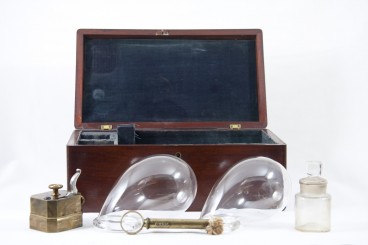Fox’s glass leech cupping set
| ACCESSION NUMBER: | 1950.4.1 a-f |
| Object Name: | Fox’s glass leech cupping set |
| Maker: | W.B. Hilliard & Sons |
| Date Made: | Circa 1850 |
| Country of Origin: | Scotland |
| MeSH Code: Medical Subject Headings | Bloodletting — instrumentation; Cupping — set |
ARTEFACT DESCRIPTION
The practice of phlebotomy (bloodletting) has origins in ancient Greece. Until the 19th century, doctors believed that the body comprised four basic elements known as the humours; blood, phlegm, yellow bile, and black bile. A healthy person had a good balance of these humours. If these became imbalanced, illnesses such as fever and inflammation could occur. Purging, starving, vomiting, or bloodletting would rid the patient of an excess of one of the humours.
Cupping was an adjunct to general phlebotomy – a way to bring an excessive concentration of blood to the skin and away from deeper problem sites. The cupping glasses in this set get their name from the medicinal leech, nature’s answer to bloodletting, employed by physicians since ancient times. Developed by English physician Francis Fox, Jr. in 1827, the glass leech was a technological improvement over earlier cupping methods. In ‘dry’ cupping, the heated glass was placed over the skin in the area where blood was to be drawn. The vacuum created brought blood to the surface. The cup was removed and the brass device in this kit known as a scarificator was then used to cut incisions into the skin. ‘Wet’ cupping followed to draw and collect the blood from the surface vessels more freely.
This cupping set was originally used by Dr. Allan Cameron, who practised in Owen Sound, Ontario from 1857 to 1912. By 1900 cupping had become a rarely used procedure.
Related: ‘Uncurables’









Leave a Reply